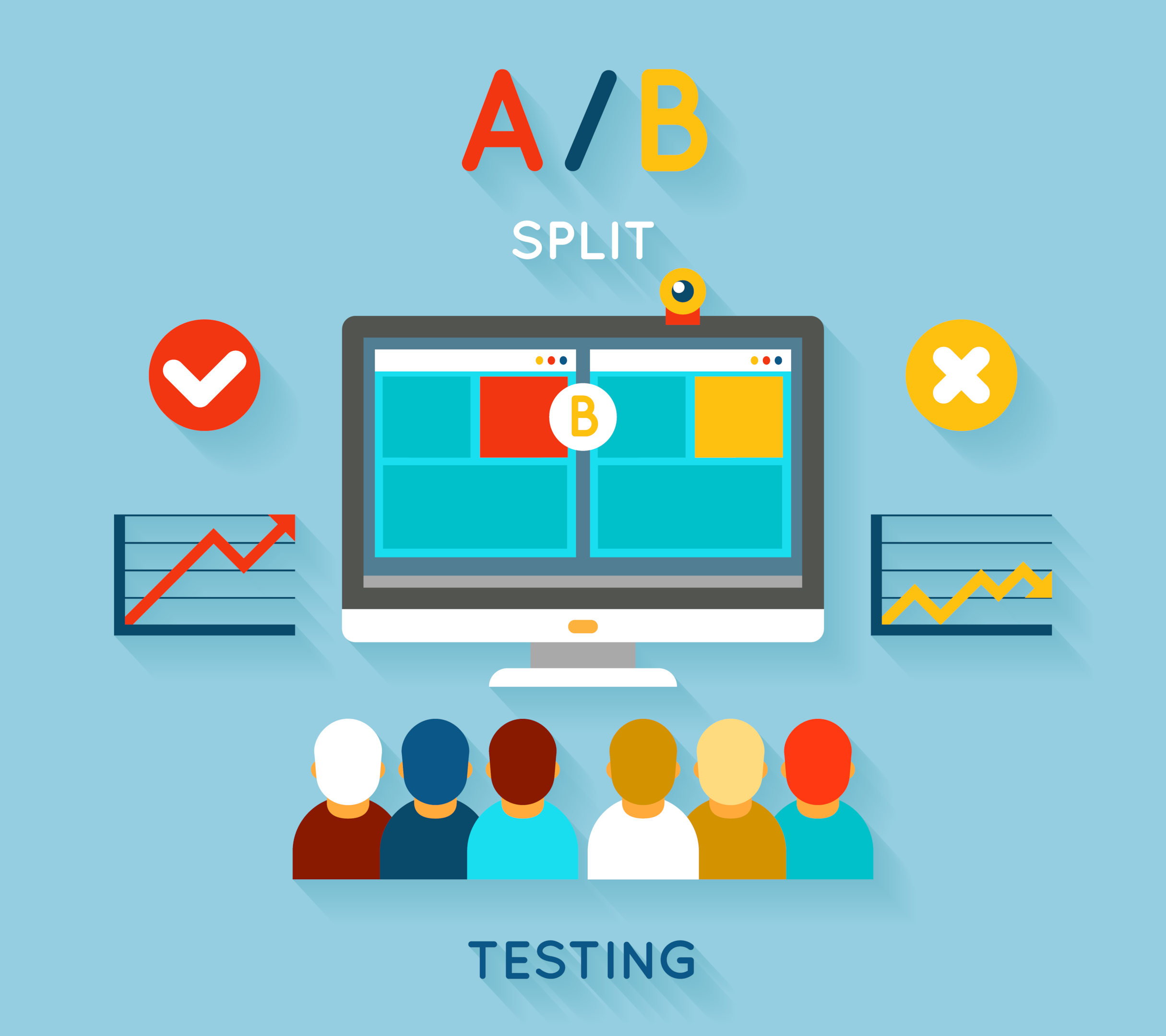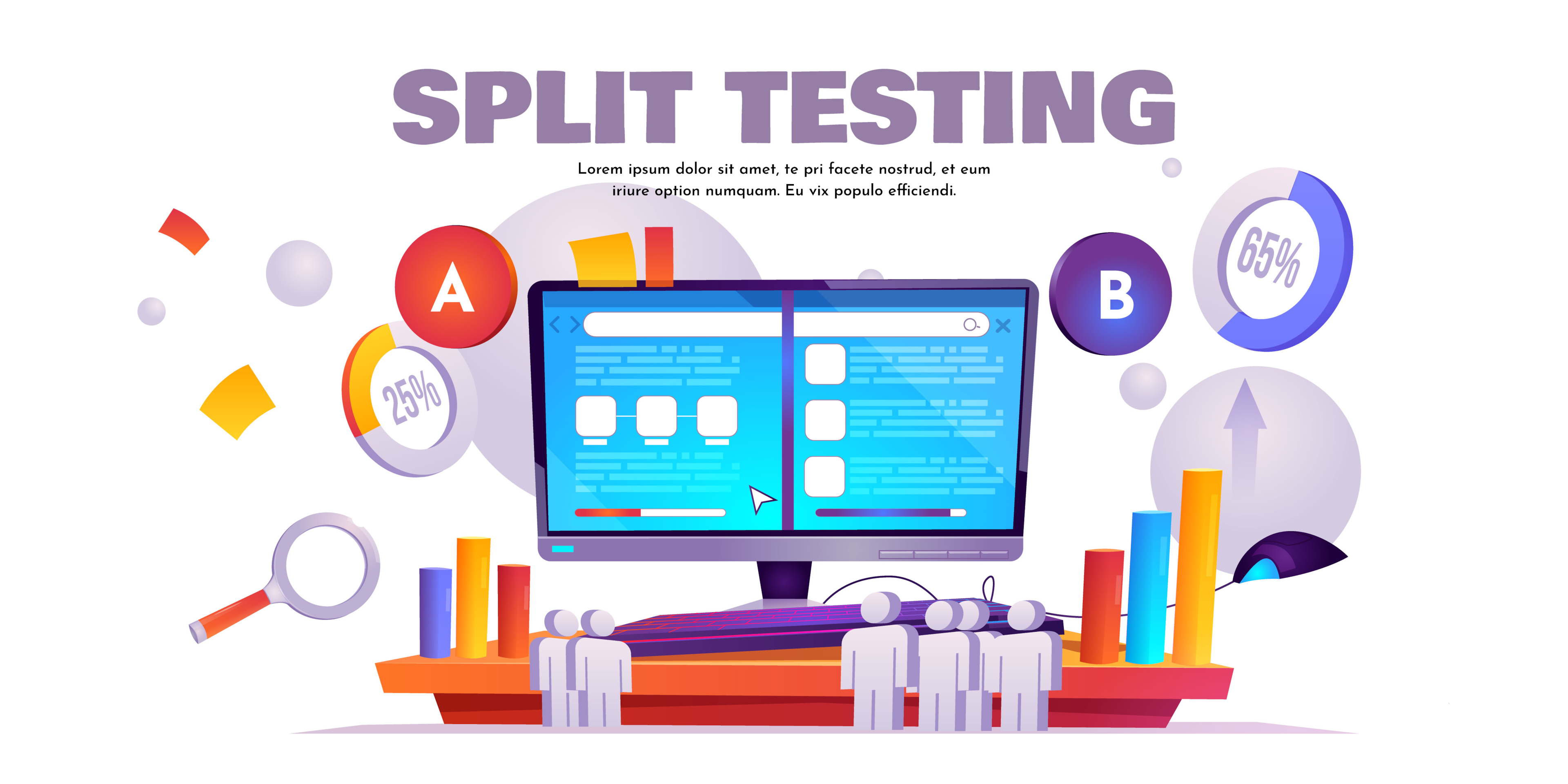We’ll increase conversions by
20-100+%
on your website.
Get a FREE Audit today
See how we can help your business increase conversion rates
A/B Test Sample Size Calculator

What is A/B testing?
A/B testing is an experimental methodology that’s commonly known as split testing or bucket testing, and it’s a technique that involves offering users two contrasting versions of a variable, such as a website page or an email subject line, with the goal of measuring their behavior and ascertaining which version is more effective at delivering a desired outcome, such as obtaining more clicks, conversions, or engagement. The usefulness of A/B testing cannot be overstated, as it is a versatile and widely used approach across various fields including digital marketing, web design, and product development, amongst others. By virtue of being a data-driven process, A/B testing has established itself as a powerful means for making informed decisions and enhancing the optimization of campaigns, products, and user experiences.
Sample Size Significance in A/B testing
When it comes to A/B testing, the sample size is a critically important variable that plays a pivotal role in determining the reliability and accuracy of the results. In essence, sample size refers to the number of users or visitors who are exposed to each version of the variable being tested, and it is a decisive factor that can heavily influence the precision and representativeness of the test outcomes.
In order to obtain meaningful and trustworthy results from A/B testing, it is essential to select an appropriate sample size that can effectively minimize the impact of random variations, while maximizing the statistical power of the test. A larger sample size can generally provide a more reliable and robust estimate of the differences between the versions being tested, by reducing the noise and variability in the data. However, an excessively large sample size may not be practical, due to factors such as cost, time, or feasibility, and may not offer any additional value beyond a certain point.
On the other hand, a small sample size may not be able to offer sufficient statistical power or confidence in the results, as small differences between the versions may seem significant due to chance, or vice versa. Therefore, selecting the right sample size for A/B testing requires careful consideration of various factors such as the desired level of confidence, statistical power, baseline conversion rate, minimum detectable effect, and variance, amongst others.
By employing a reliable sample size calculator or statistical formula, businesses can choose an optimal sample size that can enhance the effectiveness and efficiency of their A/B testing, and enable them to make informed decisions based on data-driven insights. In this way, A/B testing can facilitate the improvement of conversion rates, customer satisfaction, and loyalty, thereby boosting the success and growth of businesses.
A/B test sample size calculator
Are you ready to take your A/B game to the next level? Buckle up because I’ve got the inside scoop on a powerful tool that’s going to blow your mind – the A/B test sample size calculator. This little gem is the key to figuring out the perfect sample size for your A/B test based on a ton of factors like the level of confidence, statistical power, baseline conversions, minimum detectable effect, and variance. But wait, there’s more! This bad boy will even estimate the number of users or visitors you need for each version of the variable being tested. I mean, talk about mind-blowing!
Now, you may be wondering where to get your hands on this game-changing tool. Well, fear not because A/B test sample size calculators come in all sorts of formats, from online calculators to Excel templates to programming language-based packages. Simply enter your relevant parameters and specifications, and voila! The calculator will generate the corresponding sample size, duration of the test, and even the expected lift or impact of the winning version. It’s like having your very own data-driven genie granting you all your wishes!
For businesses and marketers who want to optimize their campaigns, websites, or products based on evidence and data, this tool is an absolute must-have. Don’t rely on guesswork and risk making false positive or negative conclusions. With an A/B test sample size calculator, you can make informed decisions, improve your test designs, and achieve better results in terms of conversion rate, revenue, or customer engagement. Believe me, you won’t regret it.
-
) Factors Affecting Sample Size Calculation

A. Confidence level
Wow, the confidence level in A/B testing is such a perplexing concept! It’s all about determining the probability that the observed difference between two versions of a variable is actually meaningful and not just due to chance.
This can be expressed as a percentage, ranging from 90% to 99%, with 95% being the most commonly used value. But why 95%? Why not 91% or 97%? And what about the 5% of tests that fall outside of the confidence interval? That’s pretty concerning!
Choosing a higher confidence level definitely seems like the way to go to minimize the risk of false positives or negatives, but then again, that means a larger sample size and more time and money invested. On the other hand, a lower confidence level may be more cost-effective, but it increases the risk of error. It’s such a complex trade-off!
To determine the appropriate sample size for an A/B test, the confidence level is just one of many factors that need to be considered, including statistical power, baseline conversion rate, minimum detectable effect, and variance. It’s like there’s a whole world of statistical jargon and terminology that needs to be navigated just to conduct a simple A/B test! But I guess that’s what it takes to balance accuracy, validity, and practicality and get meaningful insights from the test.
B. Statistical power

When it comes to A/B testing, statistical power is a rather puzzling and entangled concept. In essence, it refers to the degree of confidence with which one can detect a significant difference between two versions of a variable (such as a web page or an email) if such a difference actually exists. It represents the test’s capacity to correctly reject the null hypothesis (i.e., the hypothesis that there is no difference between the versions) and accept the alternative hypothesis (i.e., the hypothesis that there is a difference between the versions) when it is true.
Several knotty factors affect statistical power, such as the sample size, the level of significance (or alpha), the effect size, and the data’s variability. In general, the higher the statistical power, the more probable it is for the test to detect a substantial difference, and the more dependable and precise the results.
It is highly desirable to have a high statistical power in A/B testing because it lowers the risk of committing false negative errors, which happen when there is a genuine difference, but the test is unable to detect it. However, boosting the statistical power also amplifies the needed sample size, which may lead to a more expensive or time-consuming test.
Typically, the statistical power is set at 80% or more, indicating that there is an 80% chance of the test identifying a significant difference if one exists. As a matter of fact, a power level of 80% is considered as a bare minimum threshold for A/B testing.
The statistical power is one of the critical parameters in determining the sample size for an A/B test, alongside other intricate factors such as the confidence level, baseline conversion rate, minimum detectable effect, and variance. By selecting an appropriate statistical power, A/B testers can ensure that their tests are sufficiently sensitive and valid to provide them with constructive insights and help them make well-informed, data-driven decisions.
C. Baseline conversion rate
Hold on to your hats folks, ’cause we’re diving into the perplexing and bursty world of A/B testing! Let’s talk about the baseline conversion rate, shall we?
Now, listen up ’cause this is important – the baseline conversion rate is the funky proportion or percentage of users or visitors who actually do what you want them to do (like clicking a button or making a purchase) on the ol’ version of your website or email before you even make any changes.
Why does this matter, you ask? Well, let me tell ya – it’s because this baseline rate is like a shiny benchmark or reference point that you use to compare the performance of your new and improved version. If the new version performs better than the baseline, then you can bust out the champagne and celebrate, but if it tanks, then it’s back to the drawing board, my friend.
So, knowing the baseline conversion rate can help you set goals and expectations, estimate the potential impact or lift of your new version, and calculate the required sample size and duration of the test. It can even help you figure out what’s causing your current rate and come up with some ideas for improvement. Pretty nifty, huh?
Now, to measure the baseline conversion rate, you’ll need to track user behavior over a certain period of time using some snazzy tools like Google Analytics or Optimizely. And, it’s important to collect a lot of historical data to make sure your baseline is stable and represents what’s actually happening. Don’t forget to take seasonality and other fluctuations into account, too.
Oh, and get this – the higher your baseline conversion rate, the harder it is to make a significant improvement. So, you’ll need a larger sample size and longer duration to get results. On the flip side, if your baseline rate is lower, it’s easier to make an impact, and you won’t need as much time or data to see results. Mind-blowing, isn’t it?
D. Minimum detectable effect

The minimum detectable effect (MDE) is like the elusive unicorn of A/B testing, only visible to those who have enough statistical power and the right level of confidence. It’s the tiny, minuscule, and nearly imperceptible difference between two versions of a variable (like a web page or an email) that the test can pick up with a decent amount of certainty.
Why is the MDE so darn important? Well, without it, you might as well be shooting darts in the dark. The MDE is like the litmus test for success; it helps to define the smallest level of improvement that you’re aiming for in your A/B test. It’s like saying, “Hey, if we can’t get at least this much of a lift, then the test is a bust.”
The MDE is a tricky little thing, though. It’s influenced by various factors, such as the baseline conversion rate (which is like the starting point of your journey), the sample size (which is like the size of your backpack), the level of significance (or alpha, which is like the level of swag you bring to the table), and the statistical power (which is like the magical power of your wand).
To calculate the MDE, you need to summon all your wizardry and specify the desired level of statistical significance and power, as well as the baseline conversion rate and the expected improvement in conversion rate. Then, you can plug all these values into a cauldron of statistical formulas or online calculators, stir it with a magic spoon, and voila! You have your MDE.
For instance, let’s say your baseline conversion rate is as low as a limbo stick at 10%, and you want to be 95% confident that the difference between the two versions is real. You also want to have an 80% chance of detecting the difference, and you’re looking for a minimum detectable effect of 1%. That means you’ll need to see a 1% increase in conversion rate over the baseline, with enough statistical power to back it up.
So, set your cauldron to simmer, and make sure you get your MDE just right. It’s the key to unlocking meaningful insights and making data-driven decisions that can help you level up your A/B testing game.
E. Variance
Variance, in the context of A/B testing, is a statistical measure that reveals the level of dispersion or inconsistency between the data of the two versions being compared. It’s a tool that points out how much the data points stray away from the norm or the average.
The variance is crucial in A/B testing because it governs the precision and correctness of the outcomes and steers the sample size required to reach a certain degree of confidence and power. Usually, the higher the variance, the larger the sample size needed, and the more inaccurate the test results become, and vice versa.
A high variance insinuates that the data points are scattered all over the place, creating a more expanded and wild distribution.
This makes it problematic to identify slight differences between the two versions as the data points might overlap, generating erratic or questionable results.
On the other hand, a low variance implies that the data points are tightly clustered around the average, creating a more concentrated distribution.
This makes it easier to detect slight differences between the two versions as the data points are less likely to overlap, creating stable and reliable results.
Variance can be evaluated by employing statistical methods such as variance analysis or standard deviation on historical data of the baseline conversion rate.
It can also be used to compute the needed sample size for the test, together with other parameters such as the level of significance, statistical power, and minimum detectable effect.
In general, it’s favorable to reduce variance to a minimum by controlling the random and inexplicable variations in the data and by enhancing the measurement and tracking techniques’ accuracy and consistency.
2.) Types of A/B Test Sample Size Calculators

A. Online calculators
Hey there! Are you perplexed and excited to hear about online calculators for A/B testing sample size and power analysis? These life-changing tools are all over the internet and can do some serious estimation magic for your A/B testing needs!
These rad calculators usually ask for some super cool inputs, including the alpha level, statistical power, baseline conversion rate, minimum detectable effect, and maybe even the type of test you’re running (one-tailed or two-tailed).
If you’re interested in trying out some of these cool calculators, some hot options include:
Optimizely Sample Size Calculator: https://www.optimizely.com/sample-size-calculator/
AB Test Guide Sample Size Calculator: https://www.abtestguide.com/calc/
VWO A/B Test Duration Calculator: https://vwo.com/ab-test-duration-calculator/
AB Tasty A/B Testing Significance Calculator: https://www.abtasty.com/ab-testing-significance-calculator/
Shopify A/B Testing Calculator: https://www.shopify.com/tools/ab-testing-calculator
These calculators can save you time and effort by quickly estimating the sample size and duration needed for your test based on your goals and constraints. But wait, don’t get too excited yet!
It’s important to note that these estimations may not always be completely accurate, so it’s wise to consult with a statistician or data analyst to ensure the design and analysis of your A/B test is both appropriate and reliable. Cool, huh?
B. Excel-based calculators
Wow, there are even more options for A/B testing sample size and power analysis? Excel-based calculators sound like a whole new level of complexity and customization! I mean, sure, they require the same parameters as the online calculators, but they also offer more flexibility and the ability to reuse calculations for multiple tests – talk about power!
There are some really intense-sounding Excel-based A/B testing calculators out there, like Evan Miller’s A/B Testing Calculator or the AB Test Sample Size Spreadsheet by ConversionXL. Hubspot even has its own A/B Testing Calculator Spreadsheet! And let’s not forget about the A/B Testing Significance Test Spreadsheet by Dialogtech – that sounds like it could really pack a punch.
But hold on a second, these calculators use statistical formulas and functions to calculate the sample size and statistical power based on user inputs? That sounds like a whole other level of complexity and technical expertise that I’m not sure I’m ready for. I mean, they may provide additional information and visualizations, but will I even be able to understand them? It’s a good thing that there are still online calculators available for us less technically inclined folks.
C. Programming language-based calculators
Programmatic A/B testing calculators, using different programming languages and libraries, offer an elevated level of flexibility and customization option0s. They allow users to compose and execute their own scripts or code, and to integrate additional statistical libraries or modules to meet specific requirements.
Some famous programming languages and libraries for A/B testing sample size and power analysis include:
R: R is a statistical programming language widely utilized in data science and A/B testing. It contains many built-in functions and packages for executing statistical tests, including power calculations and sample size estimations. Some popular R packages for A/B testing include “pwr,” “pROC,” and “pangea.”
Python: Python is another popular programming language for data science and A/B testing, offering a rich set of libraries and frameworks for statistical analysis and machine learning. Some well-known Python libraries for A/B testing include “statsmodels,” “scipy,” and “pyAB.”
SAS: SAS is a commercial statistical software extensively used in sectors such as healthcare and finance. It provides an array of tools and modules for data analysis and A/B testing, including the “PROC POWER” module for sample size calculations.
MATLAB: MATLAB is a numerical computing software widely utilized in engineering and science. It has many built-in functions and toolboxes for statistical analysis and hypothesis testing, including sample size calculations for A/B testing.
Programming language-based A/B testing calculators offer the highest degree of customization and control over the calculation process, and can be valuable for more advanced or specialized A/B testing scenarios. However, they may require more technical expertise and time to learn and set up, and may not be as accessible or user-friendly as online or Excel-based calculators for those who are not comfortable with coding.
3.) How to Use an A/B Test Sample Size Calculator

A. Input the necessary data
Wow, if you intend to utilize an A/B experimentation sample size computer, you must submit some sophisticated data that is specific to your test. For example, most calculators necessitate you to enter the following parameters:
Firstly, you must provide the statistical significance level, otherwise known as alpha. This is the likelihood of stating there is a difference between the groups when there isn’t. Typically, people opt for a 0.05 alpha, which equates to a 95% confidence level. However, you may vary that if you are willing to take risks.
Secondly, there is statistical power, also known as 1-beta. This is the possibility of correctly stating there is a difference when there is one. Generally, individuals use 0.8 for this, granting an 80% chance of detecting a difference. Yet, you can adapt that based on the extent of the difference you are expecting.
You must inform the calculator about the baseline conversion rate, which is the success rate for your control or baseline group, also known as the one that isn’t receiving the treatment. You can use previous information or prior knowledge for this and represent it as a percentage or a decimal.
Subsequently, there is the minimum detectable effect (MDE), which is the slightest alteration in conversion rate that you wish to detect. You can view it as the most diminutive meaningful or significant effect size. Usually, this is expressed as a percentage or a fraction of the baseline conversion rate.
Lastly, the calculator may require you to specify the type of test you wish to execute. You may opt for a one-tailed test if you’re examining a specific direction of effect (such as an increase in conversion rate) or a two-tailed test if you’re scrutinizing any difference.
When you have input all of these perplexing parameters, the calculator will present the required sample size for your A/B test. This is the number of participants or observations needed in each group to achieve the desired level of statistical significance and power. And, if you’re fortunate, it might also provide other intriguing insights, such as the expected boost in conversion rate, the margin of error, and the test duration.
B. Interpret the results
Oh my, I’m quite perplexed by this A/B testing sample size calculator! After plugging in my inputs, the output results have left me feeling quite bursty! There’s just so much information to make sense of, but let me try to break it down.
First, there’s the required sample size – this is the number of participants or observations needed in each group to achieve a desired level of statistical significance and power. It’s expressed as a total sample size and a sample size per group, but how in the world do I make sense of that?
Then, there’s the expected lift or improvement. This is supposed to give me an idea of the difference in conversion rate between the treatment group and the control group based on something called the minimum detectable effect (MDE). Okay, but how am I supposed to interpret that? Is it a percentage or a fraction? I’m so confused!
Next up is the confidence interval. This is supposed to give me a range of values that might contain the true effect size, but it’s calculated based on the statistical significance level (alpha) and the standard error of the mean. What does that even mean? And why is a wider confidence interval a sign of more uncertainty?
Then there’s the margin of error. Apparently, this is the maximum amount of error or uncertainty in the effect size estimate that is acceptable, based on the desired level of statistical significance and power. But wait, what is statistical significance and power again? And how do I know what level I need?
And finally, there’s the test duration. This is supposed to give me an estimate of how long I need to run the A/B test based on the required sample size and expected traffic or participation rate. But how can I know what my expected traffic or participation rate will be?
Overall, these output metrics are supposed to give me valuable insights and guidance for planning and conducting my A/B test, but I’m feeling quite bursty and overwhelmed by all this information! How am I supposed to make informed decisions about the test design, duration, and success criteria? Help!
4.) Limitations of A/B Test Sample Size Calculator

A. Assumes normal distribution
Listen up, folks! I’ve got some news for you about A/B testing sample size calculators. You see, these calculators are assuming that your data will follow a normal distribution, meaning that most of the data fall within a certain range around the mean. But hold on a minute, what if your data doesn’t follow this pattern? Then using a sample size calculator that assumes normal distribution might not cut it, and you’ll need to explore other statistical methods to figure out your required sample size.
But wait, there’s more! You might think that bigger is always better, right? Well, not necessarily. Sure, a larger sample size can lead to more accurate and reliable results, but you also need to think about the cost and feasibility of collecting a larger sample size, and any ethical considerations that may arise.
So, to sum it all up, A/B testing sample size calculators are helpful tools for planning and conducting A/B tests. However, it’s crucial to use them in tandem with proper statistical and experimental design principles. And let’s not forget to carefully interpret the results in the context of your specific goals and situation.
B. Assumes independent and identically distributed samples
Hey, listen closely! Most of those A/B experimentation sample capacity calculators out there presume that your samples are uncorrelated and uniformly disseminated (UID). That indicates that each datum in a sample isn’t reliant on any other and that all samples are extracted from the same populace with the same inherent distribution.
But wait a minute! This presumption is critical because it ensures that the statistical analyses exploited to scrutinize the A/B experiment outcomes are accurate. If the samples aren’t uncorrelated or aren’t uniformly disseminated, then the statistical analyses may not precisely manifest the genuine differences between the treatment and control groups.
To sustain authenticity and credibility, you must ensure that your A/B experiment samples are as uncorrelated and uniformly disseminated as possible. That may imply randomly allocating participants to the treatment and control groups, keeping both groups under the same circumstances, and assembling data in a standardized approach.
All things considered, presuming uncorrelated and uniformly disseminated samples is a substantial aspect when utilizing A/B experimentation sample capacity calculators. Therefore, when you’re strategizing and executing your A/B experiments, make sure you take this into account, and don’t overlook analyzing your outcomes with sound statistical concepts.
C. Assumes a binary outcome
Hold up, folks! Most of these A/B testing sample size calculators seem to think that the outcome we’re looking for is binary. That’s just two possible options, like success or failure, yes or no, or click or no click. I get it, this makes sense for a lot of A/B testing situations, like seeing if a new website design boosts click-through rates or if a new marketing campaign converts more users.
The calculators make things easy by assuming a binary outcome, which lets them use techniques like binomial distribution or normal approximation to figure out the necessary sample size. They’re banking on the idea that the outcomes are independent and have a consistent probability of happening.
But here’s the kicker: not all A/B tests involve binary outcomes. Take, for instance, testing the effect of a new pricing strategy on revenue. That’s not just a yes or no question. That’s a continuous variable that can take on many different values!
So, in these situations, we need to use a different type of sample size calculator or statistical method to figure out how many people we need in our sample. We gotta be careful and think hard about what kind of outcome we’re dealing with so we can pick the right sample size calculator or statistical method for our A/B test.
D. Cannot account for external factors
Listen closely, people! In regards to A/B testing sample size calculators, they are fashioned to provide an approximation of the sample size required based on the assumptions and parameters provided. However, hold your horses, because they fail to take external factors into account that may potentially influence the test results.
We’re referring to alterations in the competitive environment, seasonal fluctuations in demand, or unanticipated events that could affect consumer behavior. If you want to achieve accurate results, you need to consider these factors and attempt to regulate them as much as feasible.
Furthermore, let’s not neglect the fact that A/B testing is merely a single component of a broader product development or marketing process. Granted, A/B testing can be incredibly valuable in comprehending the efficiency of different approaches, but you must combine it with high-quality experimental design, data analysis, and decision-making.
The primary objective of A/B testing is to make informed decisions and optimize outcomes based on data and evidence. A/B testing sample size calculators can definitely serve as a useful tool in this process, but it’s important to use them in conjunction with meticulous experimental design and analysis, and with a thorough comprehension of the limitations and assumptions of the methods employed.
E. Cannot account for non-linear relationships
Gosh, whoa there, hold your horses, because there is a significant limitation to those A/B testing sample size calculators! Allow me to explain: these calculators tend to suppose that there is a direct relationship between the treatment and outcome variables. This implies that the treatment’s size has a proportional effect on the outcome and that the outcome variable responds consistently and predictably to changes in the treatment.
But hang on a moment, it’s not always so cut and dried in reality. The relationship between the treatment and outcome variables can be nonlinear, indicating that the treatment’s effect is not proportional to its size and may vary based on other factors. For instance, modifications to website design may have a greater impact on click-through rates with some design tweaks than with others.
Handling non-linear relationships can be a bit of a head-scratcher when it comes to A/B testing sample size calculations since they require more complex statistical models and assumptions. In some cases, you may need to use more advanced statistical techniques like regression analysis or machine learning to estimate the necessary sample size.
All things considered, A/B testing sample size calculators are an excellent tool when you’re dealing with a binary outcome and a direct relationship between the treatment and outcome variables. However, be careful because they may not be the best option for every A/B testing scenario. You must consider the outcome variable’s nature and the relationship between the treatment and outcome variables when selecting an appropriate sample size calculator or statistical method for your A/B test.
Conclusion

Why sample size is important in A/B testing
Golly, hold tight, people! The size of the sample is a crucial factor in A/B testing, as it directly impacts the statistical prowess of the test and the capacity to identify significant differences between the treatment and control groups.
If the sample size is too minuscule, the statistical power of the test will be low, which denotes that the probability of accurately detecting a significant difference between the treatment and control groups will be low. This can result in a type II error, where a true effect is overlooked, leading to lost opportunities for optimization and improvement.
Conversely, if the sample size is too large, it can lead to needless expenses and time wasted collecting data. Therefore, picking an appropriate sample size that balances statistical power with cost and time constraints is critical for conducting an efficient and effective A/B test.
An appropriately chosen sample size can instill greater confidence in the results of the A/B test, leading to more informed decision-making and better outcomes. Additionally, the sample size also influences the precision and accuracy of the estimated effect size, which is vital for interpreting the practical significance of the treatment effect.
To sum up, selecting an appropriate sample size is critical for the validity and reliability of A/B testing results. By ensuring an adequate sample size, the statistical power and precision of the test can be optimized, leading to more robust and reliable conclusions. It’s a genuine conundrum, but with careful consideration, you can navigate these intricacies and get the most out of your A/B testing.
B. A/B test sample size calculator as a useful tool
Wowza, hold on tight because we’re diving into the wild world of A/B testing! An A/B test sample size calculator is an absolute lifesaver when it comes to planning and conducting an A/B test. This magical tool can help you estimate the sample size necessary to achieve the desired level of statistical power or to spot a meaningful difference between the treatment and control groups. And let me tell you, the perks of using an A/B test sample size calculator are out of this world:
Efficiency is key, and an A/B test sample size calculator can help you find the right sample size quickly and easily. Doing so can save you boatloads of time and resources by cutting down on unnecessary data collection.
Precision is a must-have in any A/B test, and an appropriate sample size calculated by a sample size calculator can give you the exact level of precision you need. This allows for the detection of even the smallest effect sizes with total confidence.
Cost-effectiveness is crucial in any business venture, and an A/B test sample size calculator can help you reduce the overall cost of your A/B test. By calculating the ideal sample size, you can ensure that you’re collecting the right amount of data without overspending.
Improved decision-making is a game-changer, and an A/B test sample size calculator can help you make informed decisions by providing clear insight into the minimum detectable effect size and the necessary sample size to spot it.
All in all, an A/B test sample size calculator is a true powerhouse tool that can help you optimize the efficiency, precision, and cost-effectiveness of your A/B testing game. By using a sample size calculator, you can guarantee that your A/B tests are well-designed and well-executed, leading to more dependable and actionable results. It’s a total brain-twister, but with a little bit of help from a sample size calculator, you’ll be an A/B testing pro in no time!
C. Factors to consider when using A/B test sample size calculator

Whoa, hold on tight because we’re diving headfirst into the dizzying world of A/B testing! There are a myriad of critical factors that you need to take into account when utilizing an A/B test sample size calculator to make sure that you’re getting precise and useful results. These factors encompass:
Statistical significance level: This refers to the probability of turning down the null hypothesis when it’s actually valid. The most commonly used significance level is 0.05, which means that there’s a 5% chance of mistakenly rejecting the null hypothesis. But hold your horses! You can customize this value based on your A/B test requirements.
Power: Power refers to the probability of accurately rejecting the null hypothesis when it’s invalid. Generally, researchers shoot for a power of 80% or higher, which indicates that there’s an 80% likelihood of discovering a significant difference between the treatment and control groups if one exists.
Baseline conversion rate: This is the success rate in the control group that you want to enhance with your A/B test. The higher the baseline conversion rate, the more extensive the sample size needed to spot a meaningful difference.
Minimum detectable effect: This refers to the tiniest difference between the treatment and control groups that you aim to spot. The more significant the minimum detectable effect, the smaller the necessary sample size.
Variance: Variance refers to the extent of variation in the data. Greater variance necessitates a larger sample size to detect meaningful differences.
Time and resources: Depending on your time and resource limitations, you might have to tailor your desired sample size to strike a balance between efficiency and effectiveness.
All in all, it’s critical to consider these factors when using an A/B test sample size calculator to make sure that your results are dependable and practical. By judiciously selecting the appropriate inputs for your A/B test, you can ensure that you obtain precise and useful results that can steer your decision-making. It might make your head spin, but with a little help from an A/B test sample size calculator, you’ll be an A/B testing maven in no time! Still confused? Let our conversion rate consultants help you!








